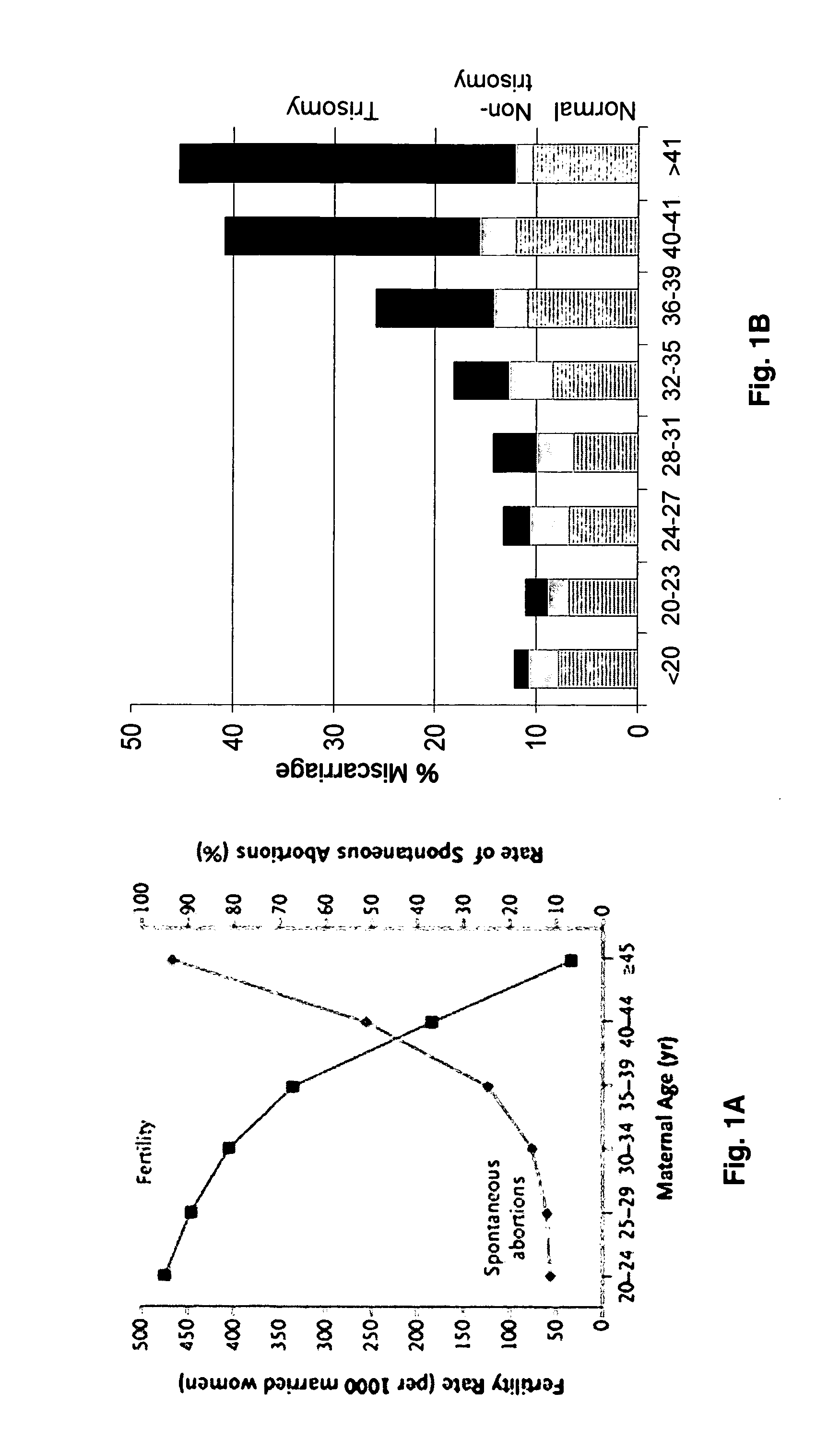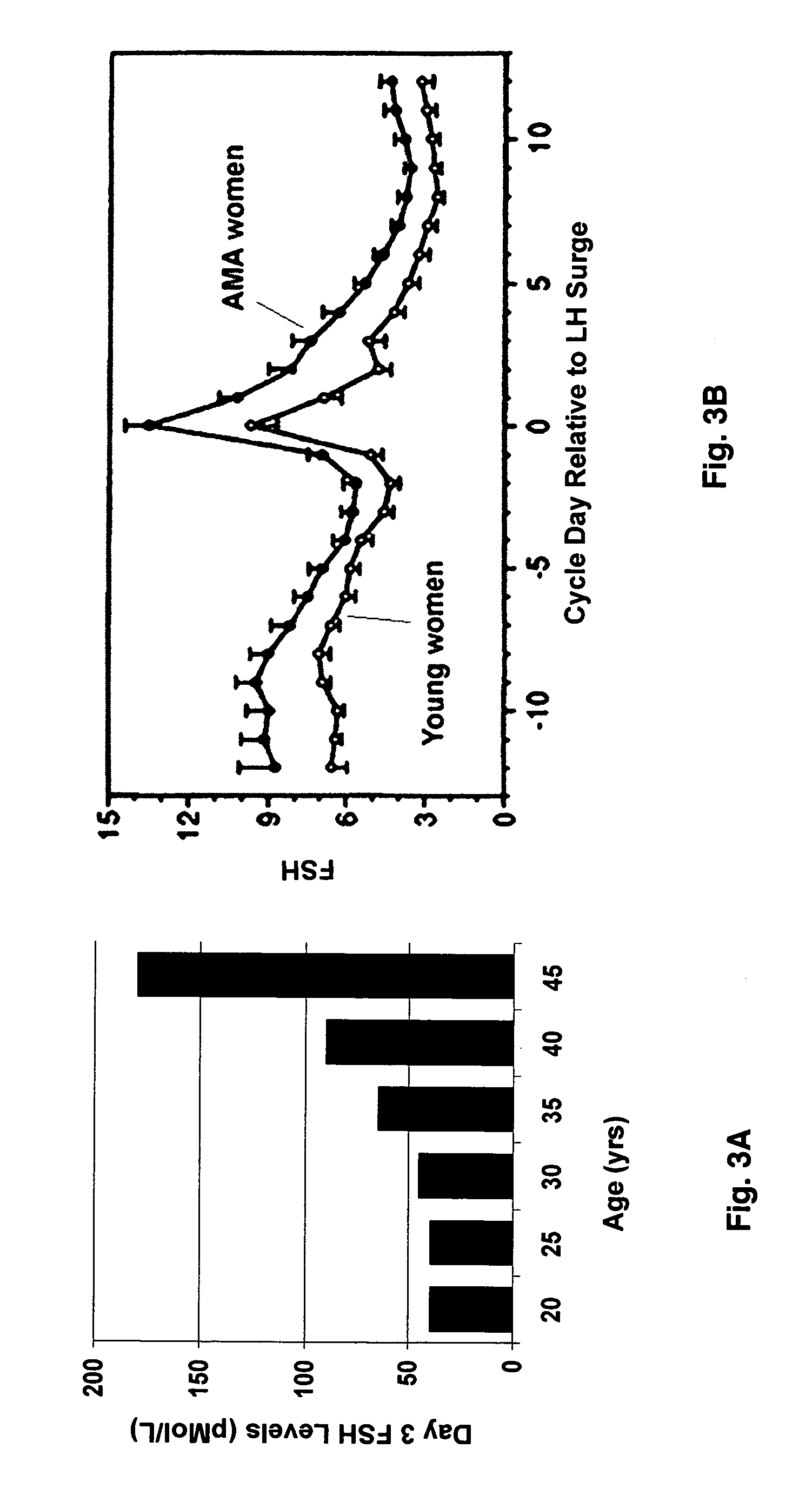Hormone normalization therapy and uses therefor
a hormone and normalization therapy technology, applied in the field of reproductive biology and reproductive endocrinology, can solve the problems of inconvenient use, no current therapies that prevent the occurrence of chromosomal abnormalities in oocytes, and the dispute over pgd prevention value, so as to and reduce the incidence of infertility
- Summary
- Abstract
- Description
- Claims
- Application Information
AI Technical Summary
Benefits of technology
Problems solved by technology
Method used
Image
Examples
example 1
Patient Groups
[0050]Women aged 35 and over are the initial subjects for these studies. Initial subjects will have high FSH, and / or high E2. They will have had 1 or more documented autosomal trisomic conceptus or 2 or more miscarriages may or may not have been karyotyped. This test group includes patients who have had Down, Patau, and Edward syndrome pregnancies. Subjects who will also be candidates for the therapy are patients with high FSH and / or E2 and a history of idiopathic infertility, premature ovarian failure, diminished ovarian reserve, or repeated implantation failure. Hormone normalization therapy has the potential to prevent a number of underlying defects. Additional criteria include normal Body Mass Index (BMI), Thyroid Stimulating Hormone (TSH), prolactin, maternal and paternal karyotypes, and uterine morphology; negative for thrombophilias associated with recurrent pregnancy loss and infertility.
example 2
Strategy of Hormonal Normalization Therapy
[0051]A fundamental objective of hormone normalization therapy is to restore young hormonal levels in advanced maternal age women in order to correct chromosomal segregation. The first central idea of hormone normalization therapy is to take control over the bodies' pituitary secretory function so that the body may be rid of ovarian exposure to chronically elevated levels of FSH. This is accomplished by downregulating pituitary secretion of FSH by daily injection of high levels of a gonadotropin releasing hormone (GnRH), or with a GnRH agonist or antagonist. LH is also downregulated in the course of the treatment. This treatment is performed for the duration of the hormone normalization therapy regimen, including during the luteal phases of the menstrual cycles that occur during the therapy, to achieve sustained pituitary downregulation throughout the duration of the therapy. The use of GnRH downregulation to achieve control over the hypotha...
example 3
Therapeutic Regimens
[0054]The Hormone Normalization Therapy (HNT) protocol in the clinical trial consists of a control cycle during which gonadotropin and steroid hormone levels are measured prior to treatment (for clinical trial purposes), a downregulation cycle, and a succession of three hormonal treatment cycles, each one menstrual cycle in duration. Patients undergo basal hormone measurements, followed by pituitary downregulation with GnRH, GnRH agonist, or GnRH antagonist, followed by several successive cycles of hormone normalization treatment with low doses of reproductive hormones designed to approximate those of a young woman as they change throughout the menstrual cycle. Patients will then attempt to get pregnant by natural conception or by intrauterine insemination. No IVF is required for these treatments. The basic protocol for hormone normalization therapy is outlined in FIG. 5
[0055]The following HNT drug regimen is provided as an outline of how hormone normalization th...
PUM
| Property | Measurement | Unit |
|---|---|---|
| time | aaaaa | aaaaa |
| diameter | aaaaa | aaaaa |
| time | aaaaa | aaaaa |
Abstract
Description
Claims
Application Information
 Login to View More
Login to View More - R&D
- Intellectual Property
- Life Sciences
- Materials
- Tech Scout
- Unparalleled Data Quality
- Higher Quality Content
- 60% Fewer Hallucinations
Browse by: Latest US Patents, China's latest patents, Technical Efficacy Thesaurus, Application Domain, Technology Topic, Popular Technical Reports.
© 2025 PatSnap. All rights reserved.Legal|Privacy policy|Modern Slavery Act Transparency Statement|Sitemap|About US| Contact US: help@patsnap.com



